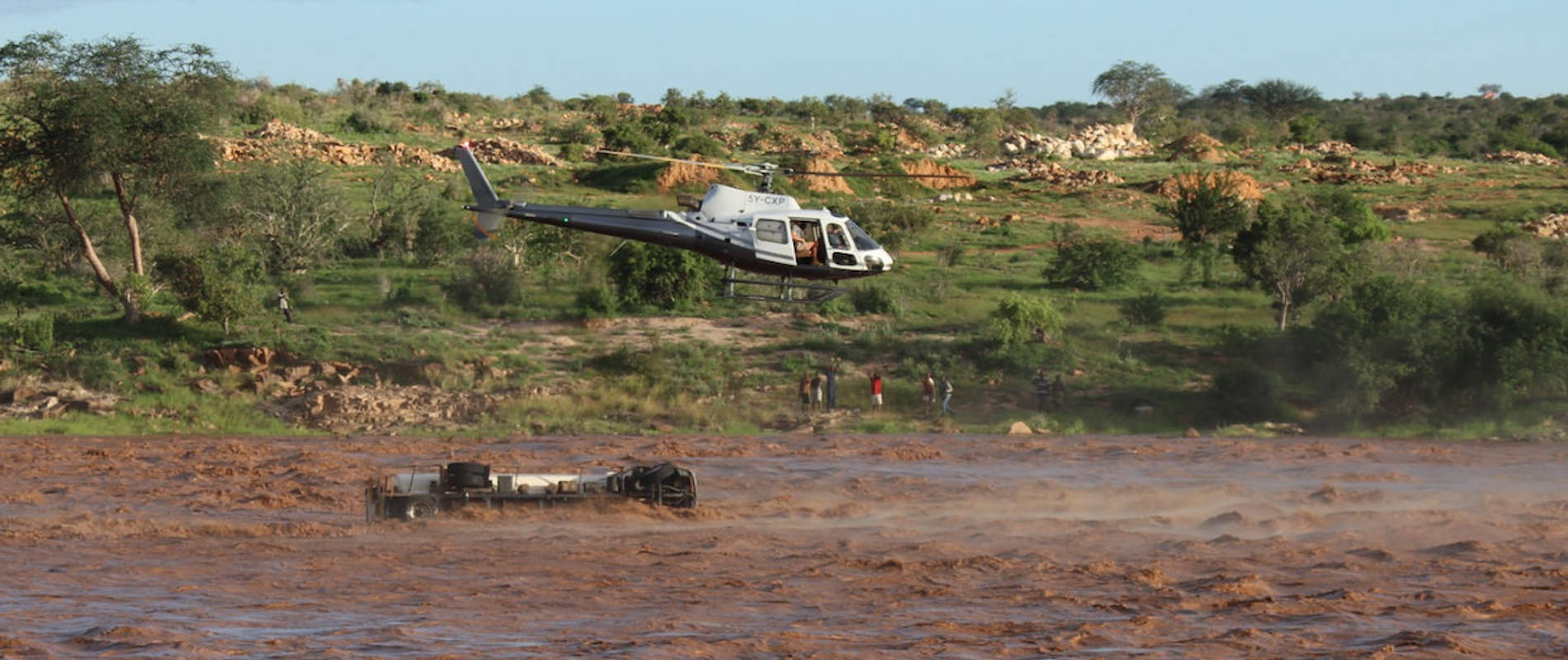The month started with a daring river rescue by two of our pilots, Taru and Roan Carr-Harley. We received the report of a fuel tanker that was stuck crossing a causeway on the Galana River, later overturning when flood waters rose pushing the tanker off the causeway completely. The driver, unable to escape through the raging waters, was trapped in the cabin.
SWT received news of his plight and sprang into action immediately. Taru Carr-Hartley, one of the Trust’s helicopter pilots flew with his brother and fixed wing pilot, Roan Carr-Hartley. With Taru at the controls and Roan hanging out of the back door, they were able to bring the helicopter to within inches of the flooded tanker and Roan, tethered to the helicopter, stepped out onto the helicopter’s skid to help the driver into the aircraft, which then flew to safety on the bank. Hundreds of nervous onlookers erupted in cheers upon witnessing this life-saving rescue.

Across the Parks there was an increase in livestock incursions, although Chyulu Hills experienced only small incursions, especially to the Southwest. Both Tsavo East and West had a large increase in the number of livestock within their boundaries, even in areas that had previously come under relative control. SWT aircrafts worked hard to support KWS in their operations inside the Park to curb the cattle incursions.

These efforts were largely successful, especially in Tsavo East where livestock had moved nearly 20 km into the Park, but was successfully pushed back to only a few kilometres into the Park before the end of the month. Similar success was achieved to the South and North of Tsavo West National Park. For example, at its peak, livestock bomas (enclosures) numbered 44 in the Southern area of Tsavo West between Kanjaro and Kavuma Hills, and this number had been reduced by KWS to only 15 by month’s end.

No poached elephant carcasses were discovered in May, however, five (5) elephant carcasses (assumed to have died of natural causes) were discovered during various aerial patrols. These included three (3) sub-adult or juvenile elephants and two (2) adult elephants, all with tusks intact, collected and handed over to KWS for safekeeping.

Despite no poached elephant carcasses being discovered, there were a number of injured elephants with suspected or confirmed arrow wounds treated with assistance from the aerial unit. The airwing was involved in a total of seven (7) cases, which resulted in six (6) elephants being attended to and three (3) elephants actually treated for injuries. Two young elephants were discovered with severe limps caused by long-suffering injuries and the decision was made to avoid the disturbance a likely futile intervention. Another elephant that had been reported with an injury near Aruba dam was searched for and unfortunately not found. Yet another injured bull (suspected arrow wound) was found during a routine fixed wing patrol in northern Tsavo East and although the vet was mobilised this bull as well vanished and could not be relocated despite significant effort over multiple days. Unfortunately, this is sometimes a reality in the thick acacia-commiphora woodland that characterizes much of Tsavo. Three treatments involving the aerial unit were successful, however.

Two elephants with arrow wounds were treated and given good prognoses, including one well-known large tusker that has been under Big Life’s observation for around a decade. Fortunately, he had shown up at Ol Donyo Wuas Lodge before it was too late, and the team was able to successfully dart him and remove a poisoned arrow, ensuring that he will have many more opportunities to pass on his rare genetics. Measurements of his tusks provided an estimate of approximately 130 lbs per tusk! Another elephant, found dragging a leg on Galana Ranch near a SWT camp, was located by fixed wing and later darted and treated by a vet from the ground for treatment. Finally, an elephant with a severe limp caused by a deep snare, found by a ground team was darted from a helicopter and successfully treated and snare removed. Unfortunately the vet was only able to give this elephant a guarded prognosis due to the depth and severity of the injury.

Another special operation undertaken with assistance from the Aerial Unit was the removal of wildlife struck inside the National Irrigation Board’s fenced farm on Galana Ranch. Several vehicles and 200 men and women on the ground were guided from the air to form an extended line and pushed dozens of stranded animals out of a small opening in the fence.
The operation was not without significant challenges, however, a total of 90 grant’s gazelle, 5 kongoni, 2 oryx, 3 eland and 3 zebra were successfully pushed out. This represented the majority of wildlife inside the farm at the time.

The highlight of the month was the sighting of a female rhino in Tsavo East that had gone undetected for several months and was feared dead. With her was an approximately 6-7 month old calf, bringing the official Tsavo East population up to 26 individuals, almost three (3) times the population from the low of nine (9) individuals that survived years of intense poaching.
